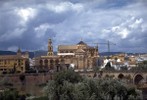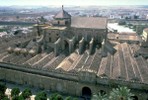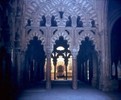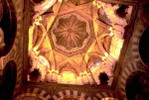Previous Lecture | Next Lecture
Concepts
Ifriqiya: Present day Libya, Tunisia, and most of Algeria.
Al-Andalus: Southern Spain, but used in Arabic sources to designate all of Islamic Spain.
Ribat: Originally designated a building type that was both military and religious in character. It was a fortified barrack for those volunteers (murabitun) whose piety led them to devote themselves to guarding the frontiers of the Islamic state.
Qayrawan: The Islamic capital of Ifriqiya, founded by Uqba ibn Nafi' in 664. He built in it a dar al-imara (palace of the governor) and the congregational mosque which carries his name (the Mosque of Sidi Uqba).
The Aghlabids: A dynasty that ruled Ifriqiya and Sicily between 800 and 909. Their capital was at Qayrawan, and they paid tribute to the Abbasids.
The Umayyads of Spain (756-1031): After the fall of the Umayyad dynasty in 750, a scion of the family, Abd al-Rahman I, fled to Spain and established a principality in Cordoba independent of the Abbasids. His great grandson, Abd al-Rahman III (912-961) declared a new Umayyad caliphate with its capital in Cordoba.
Main Features of North African Mosques
- Hypostyle plan with arcaded porticoes on the three sides of the courtyard.
- T shaped plan of prayer hall (axial nave and transverse arcade in front of mihrab), with aisles perpendicular to the qibla wall.
- Dome above the mihrab.
- Square-based tower as minarets.
Monuments
The Masjid (or Musalla) of Bab Mardum, Toledo
(ca. 999), A neighborhood musalla with an open nine-bay plan and façades which repeat the decorative program of the great mosque of Cordoba.
The Great Mosque of Qayrawan
Founded in 670 and rebuilt several times, 773-4, 836, 863, 1294, it is the prototype for many later North African mosques. It has a unique mihrab with lustre tiles set in the spandrels, and carved marble panels inside the niche.
The Ribat of Susa, Tunisia
A fine example of the fortress-Ribat, its core dates to the period 770-96, and its last stage of construction (821-22) is attributed to the Aghlabid Ziyadat Allah. It consists of a fortified enclosure with one entrance and attached towers in the corners and in the middle of the walls. The courtyard is surrounded by vaulted porticoes on two levels with cells behind. The southern side of the second floor is occupied by a mosque with a mihrab in its center.
The Mosque of Muhammad ibn Khairun at Qayrawan (866)
One of the earliest surviving examples of a small neighborhood mosque, it is distinguished by its nine-bay plan (which will have a major role in the development of funerary and royal architecture) and its stucco decoration.
The Great Mosque of Cordoba
Probably the most exquisite mosque of western Islamic land, founded by 'Abd al-Rahman I in 786, enlarged several times, 832-48 under Abd al-Rahman II, 962 under al-Hakam II, and 987 by al-Mansur, the vizir of Hisham II (this time it was extended to the west). The Mosque has an intricate hypostyle arrangement with double-tiered, arched supports, ribbed domes above the maqsura, and a unique mihrab-chamber with mosaic decoration.







